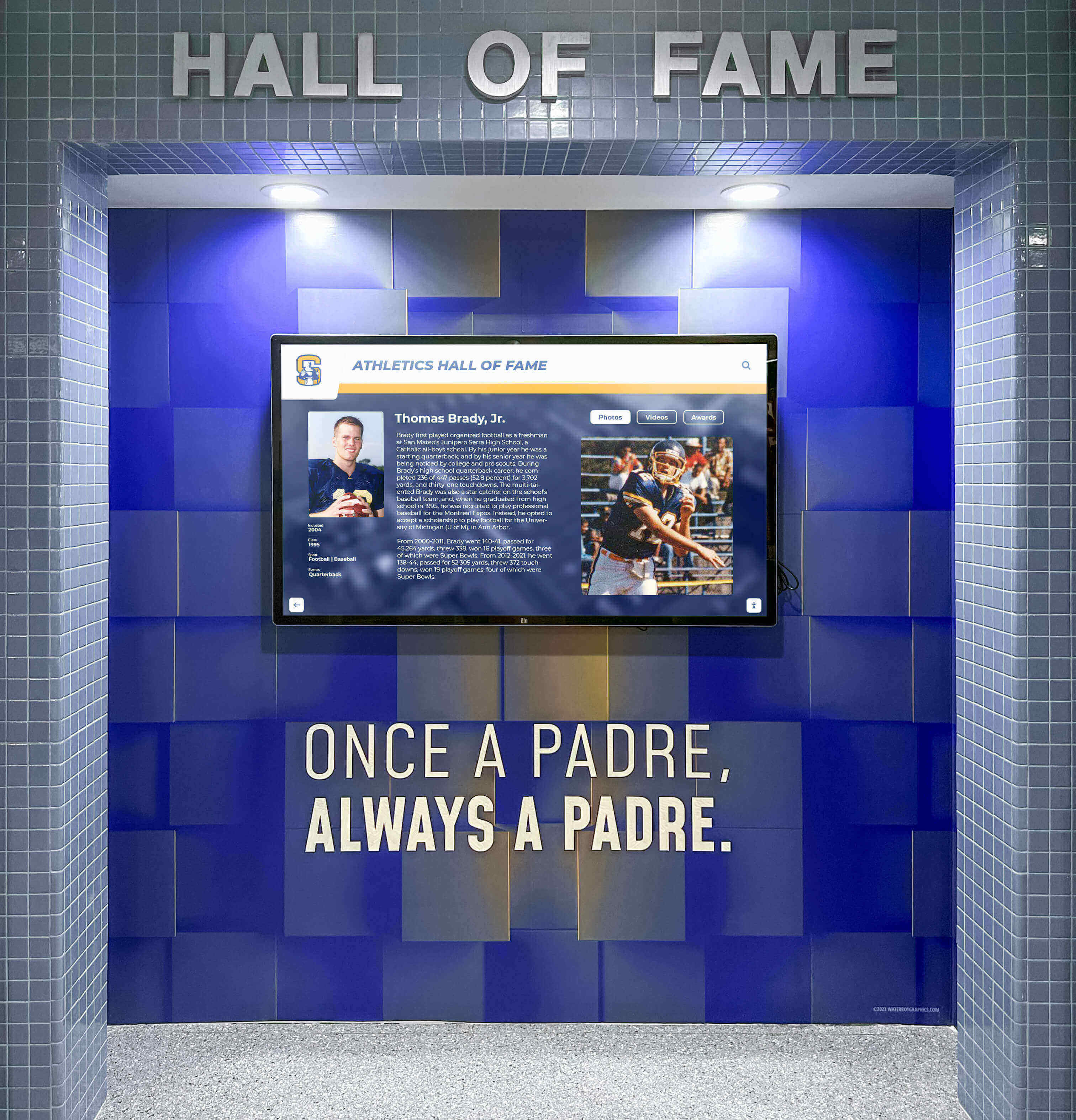Key Takeaways
Comprehensive guide for athletic directors on selecting the right digital hall of fame provider. Learn evaluation criteria, key features, budget considerations, and implementation strategies for modernizing athletic recognition.
Understanding Your Athletic Recognition Needs
Before evaluating providers, clarifying exactly what you need from a digital hall of fame system ensures you assess solutions against your actual requirements rather than being swayed by impressive but irrelevant features.
Defining Your Recognition Scope and Philosophy
Different athletic programs approach recognition with different philosophies, and your provider selection should align with your specific vision:
Comprehensive Recognition Approach aims to celebrate all forms of athletic achievement across every sport, every level, and every contribution type. This philosophy recognizes that excellence manifests in many ways—from record-breaking performances to exceptional leadership, from championship teams to individual milestones. Programs adopting this approach need systems with unlimited capacity accommodating extensive recognition without space constraints.
Selective Excellence Recognition focuses on the highest achievements—state championships, All-State selections, school records, and athletes advancing to collegiate or professional levels. This more exclusive approach maintains prestige through selectivity while requiring systems that present honored achievements with appropriate dignity and impact.
Hybrid Recognition Strategy combines selective physical displays for the most prestigious honors with comprehensive digital systems documenting broader achievement across all sports and recognition categories. Many successful programs adopt this balanced approach, honoring tradition while embracing modern capabilities.
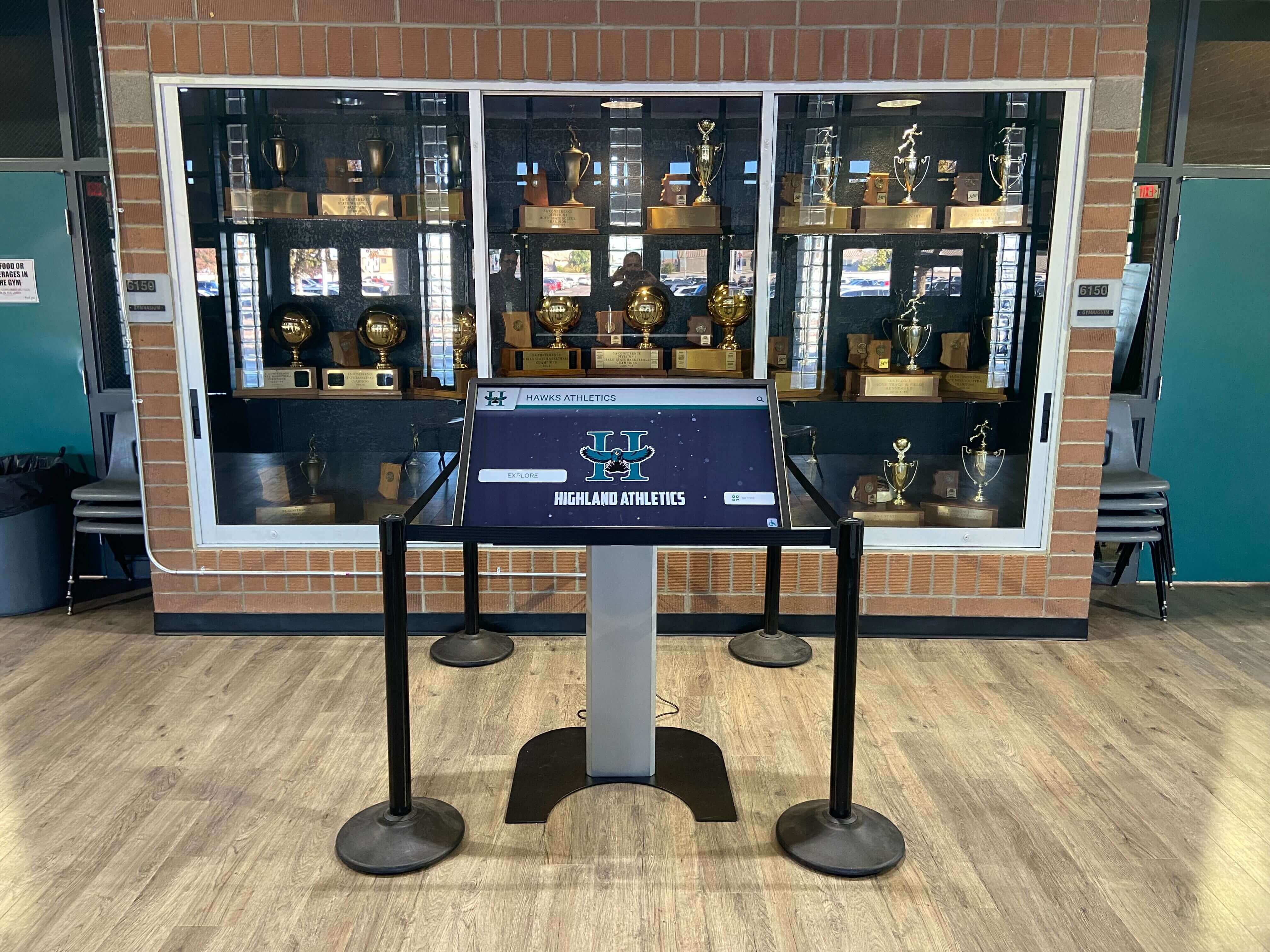
Understanding your recognition philosophy guides every subsequent decision about provider selection, feature requirements, and implementation strategy. A provider perfect for comprehensive recognition may poorly serve selective programs, and vice versa.
Current Recognition Challenges You Need to Solve
Identifying the specific problems driving your search for digital solutions helps evaluate which providers actually address your pain points:
Space Constraints plague nearly every traditional athletic recognition program. Trophy cases overflow, walls fill completely, and you’re forced to make difficult decisions about what receives recognition and what gets removed or relegated to storage. Digital systems eliminate physical space limitations, but providers differ dramatically in how many profiles they support and how easy expansion proves over time.
Update Difficulty and Vendor Dependency frustrate athletic directors managing traditional displays requiring professional fabrication and installation for every update. When adding new record holders or championship teams requires weeks of lead time and hundreds of dollars in ongoing costs, recognition loses immediacy and budget pressures mount. The best digital providers enable instant updates by your own staff without ongoing vendor charges.
Limited Information Capacity prevents traditional plaques and trophies from telling complete stories. Names, years, and basic achievements barely scratch the surface of what athletes accomplished and the journeys that led to excellence. Digital platforms supporting rich multimedia content—photos, videos, statistics, biographical narratives—transform shallow recognition into meaningful tributes, but capabilities vary widely between providers.
Engagement and Visibility Challenges occur when recognition displays become background noise that students pass without noticing. Static bulletin boards and unchanging trophy cases fade into invisibility regardless of their content. Interactive digital systems create engagement opportunities through touch exploration, but only if providers design genuinely compelling user experiences rather than just digitizing static content.
Preservation of Program History becomes increasingly urgent as decades of achievement risk being forgotten without proper documentation and display. Converting historical records, photos, and achievements into accessible digital formats requires either significant staff time or provider assistance—capabilities that vary dramatically between vendors.
Understanding exactly which challenges you face most acutely guides feature prioritization during vendor evaluation. A system excelling at multimedia storytelling provides minimal value if your primary need involves simplifying updates, while platforms offering self-service content management won’t solve engagement problems without genuinely interactive experiences.
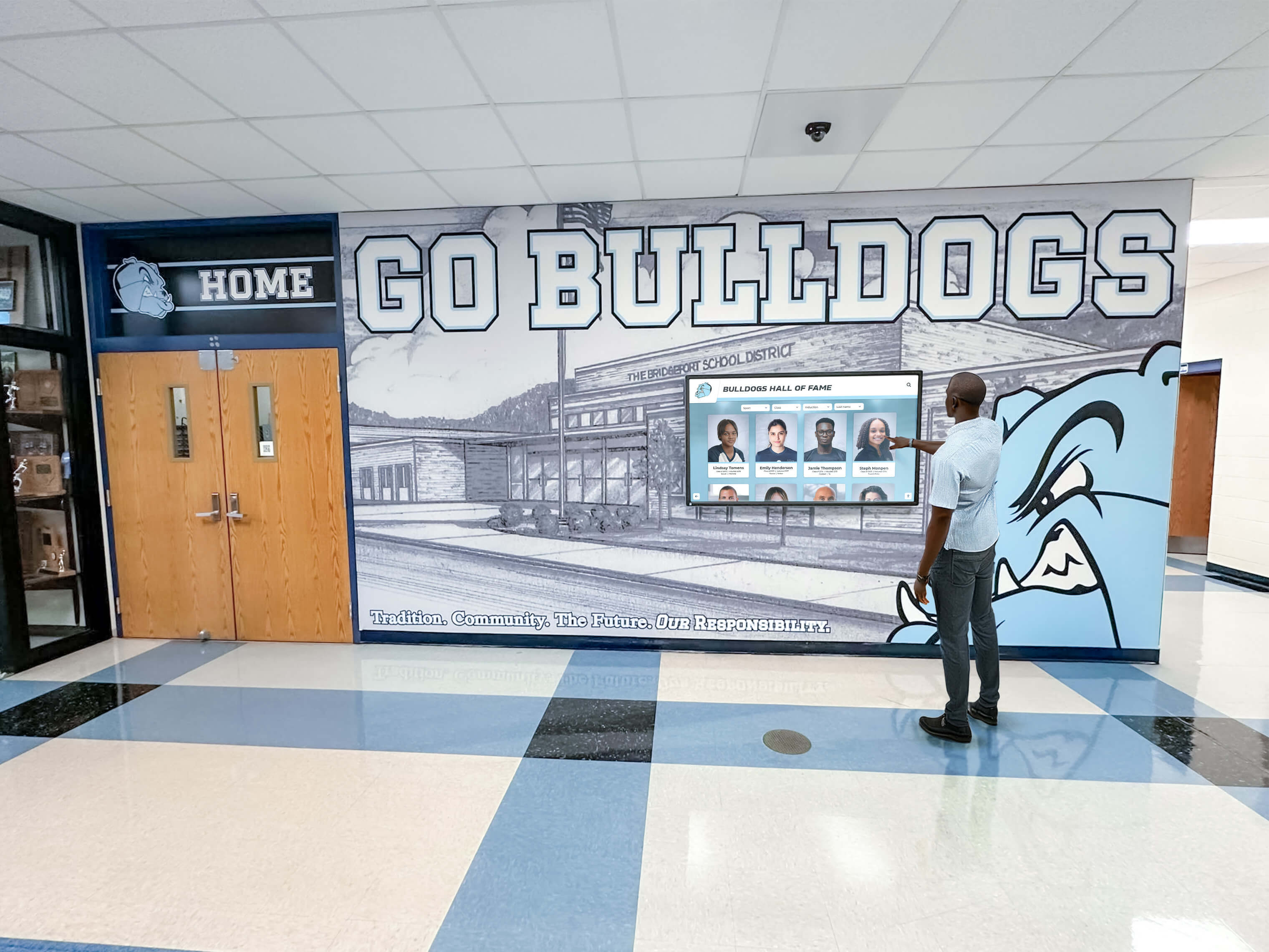
Stakeholder Requirements and Expectations
Successful digital hall of fame implementations satisfy multiple constituencies with sometimes competing priorities:
Athletes and Families want recognition that appropriately honors their significant time investments, sacrifices, and achievements. They expect systems showcasing accomplishments with professional quality, providing easy access for sharing with extended networks, and maintaining accuracy in records and biographical information. Providers offering mobile-friendly online access alongside physical displays extend recognition reach beyond your facility.
Coaches need systems simplifying their administrative burdens rather than creating additional work. They appreciate platforms enabling quick nominee submissions, straightforward approval workflows, and easy access to historical records for recruiting and motivation. Providers supporting coaches through intuitive interfaces and minimal training requirements earn stronger program adoption.
Administration and School Leadership evaluate digital hall of fame proposals through budget impact, maintenance requirements, and alignment with broader institutional goals. They prefer providers offering transparent pricing, proven reliability, and clear value propositions demonstrating return on investment through enhanced school culture, improved alumni engagement, or operational efficiencies.
Alumni and Community Members view athletic recognition as connection points to institutional traditions and shared experiences. They value systems making historical achievements accessible, enabling discovery of personal connections and team memories, and creating reasons for ongoing engagement with athletic programs. Providers offering online accessibility and social sharing capabilities strengthen these alumni connections.
Balancing these sometimes competing priorities requires understanding exactly what matters most to each stakeholder group and evaluating providers against their specific requirements. The platform that coaches find intuitive and athletes find engaging may differ substantially from the system that minimizes administrative burden—finding solutions meeting multiple needs simultaneously separates exceptional providers from mediocre options.
Critical Evaluation Criteria for Digital Hall of Fame Providers
Once you understand your needs, systematic evaluation of potential providers against consistent criteria prevents overlooking critical considerations while avoiding distraction by irrelevant features.
Content Management and Update Capabilities
The ability to add new honorees and update existing content easily determines whether your digital hall of fame remains current and relevant or becomes outdated shortly after launch.
Self-Service Content Management represents the single most important capability distinguishing modern platforms from legacy systems. Can your own staff add new records, create profiles, and update achievements without contacting the provider? Do you need technical expertise, or can any trained administrator manage content confidently? Providers offering intuitive cloud-based management platforms eliminate ongoing vendor dependencies and per-update charges that transform seemingly affordable systems into expensive long-term commitments.
Bulk Upload and Import Capabilities matter enormously when migrating existing historical data or adding multiple inductees simultaneously. Systems requiring individual profile creation become prohibitively time-consuming for programs with extensive histories. Look for providers supporting CSV imports, batch photo uploads, and efficient workflows converting years of achievement into digital profiles without endless manual data entry.
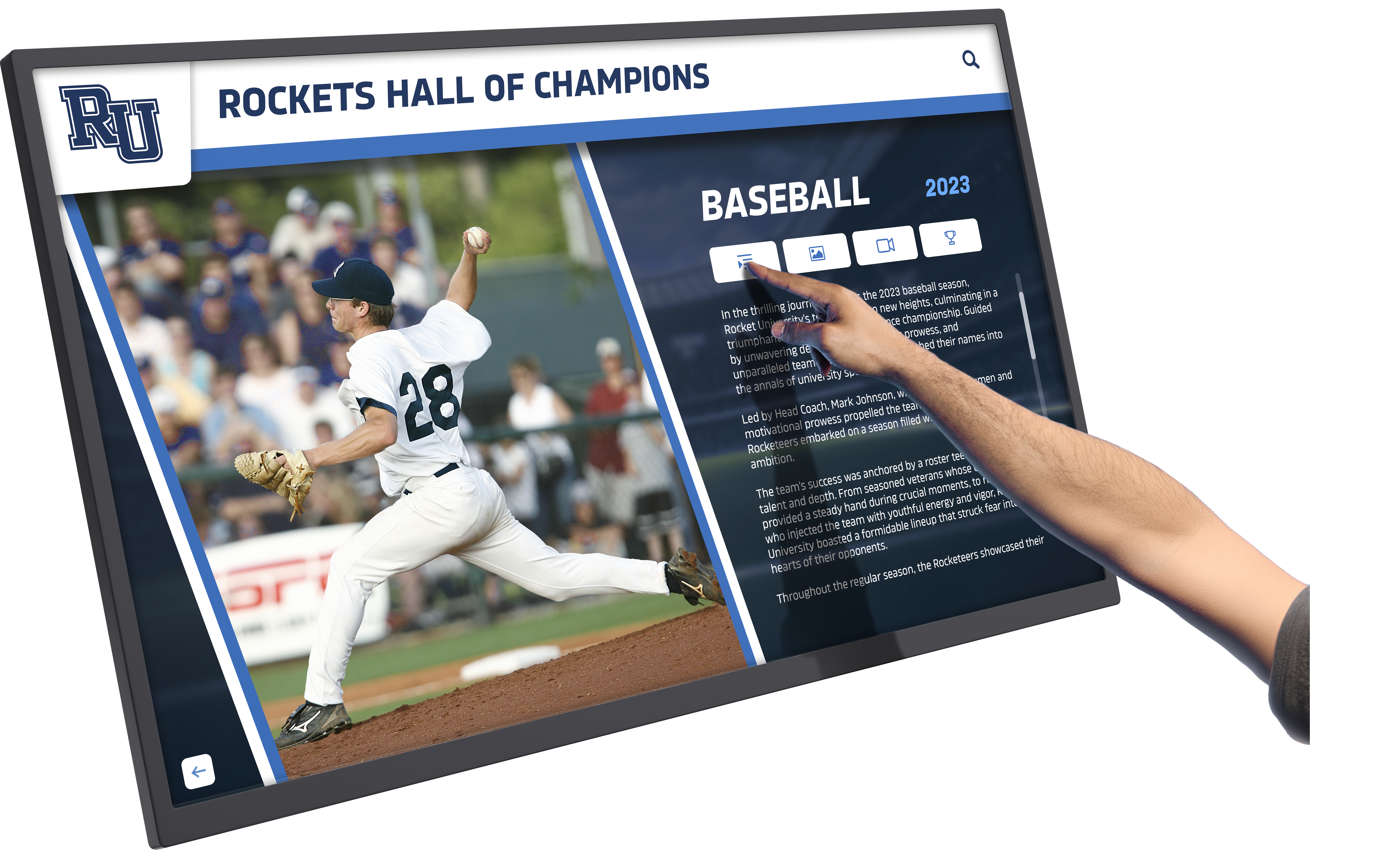
Content Approval Workflows prevent embarrassing errors while maintaining quality standards. Can you designate different permission levels—allowing coaches to submit nominees while reserving publication approval for athletic directors? Do systems provide preview capabilities ensuring content appears correctly before going live? Providers building approval processes into platforms prevent quality issues without creating bureaucratic bottlenecks.
Template and Design Consistency ensures professional appearance across hundreds or thousands of profiles created by different staff members over many years. Providers offering customizable templates, style guides, and design systems enable consistent presentation while accommodating program-specific branding and aesthetic preferences. Systems leaving design entirely to individual content creators typically result in inconsistent, unprofessional appearances undermining recognition impact.
Multi-Site Management becomes essential for districts operating multiple high schools or colleges managing athletics across various facilities. Providers supporting centralized management of multiple installations reduce administrative complexity while enabling content sharing where appropriate. If you oversee multiple athletic programs, clarify whether vendor pricing and capabilities scale effectively across your complete environment.
Interactive User Experience and Engagement Features
Digital hall of fame systems justify investment only if people actually use them—interactive features determine whether displays become destination experiences or ignored equipment.
Intuitive Touch Navigation must enable anyone—students unfamiliar with your system, visiting parents, prospective athletes—to immediately start exploring content without instructions. Complex navigation requiring explanation fails regardless of content quality. Evaluate providers by requesting live demonstrations where you test navigation yourself rather than watching practiced vendor presentations. If you can’t intuitively find content within 30 seconds, neither will your students.
Powerful Search and Discovery Tools help users find specific athletes, teams, or achievements instantly while also enabling open-ended exploration. Can visitors search by athlete name, graduation year, sport, achievement type, or record category? Do systems suggest related content—showing other athletes from the same team, additional achievements by the same person, or other record holders in the same event? Providers building comprehensive search and filtering capabilities create engaging experiences encouraging extended interaction.
📊 Analytics and Insights
Track which content resonates, understand engagement patterns, and identify popular searches revealing what matters to your community
📱 Mobile and Online Access
Extend recognition beyond physical displays through responsive web platforms accessible from anywhere
🎬 Multimedia Content Support
Incorporate photos, videos, detailed statistics, and rich biographical narratives that static displays cannot accommodate
🔗 Social Sharing Integration
Enable athletes and families to share recognition with extended networks, multiplying visibility and impact
Attract Mode and Featured Content ensure displays actively engage passing viewers when not being touched. Systems cycling through featured highlights attract attention while demonstrating capabilities to unfamiliar users. When someone approaches and touches the display, immediate responsive transition from attract mode to interactive exploration provides satisfying experiences. Providers offering flexible scheduling of featured content enable highlighting specific achievements during relevant seasons or events.
Accessibility Considerations ensure all community members can engage with recognition regardless of physical abilities. Does the provider’s interface accommodate vision, hearing, or mobility limitations? Can mounting heights serve users of various heights including wheelchair users? Modern platforms should meet Web Content Accessibility Guidelines (WCAG) standards, though compliance varies significantly between providers.
Technical Infrastructure and Reliability
Behind attractive interfaces and rich content lie technical considerations determining whether systems operate reliably for years or create ongoing headaches.
Hardware Quality and Specifications vary dramatically between providers using consumer-grade equipment versus commercial installations. Commercial displays rated for 16-24 hour daily operation, featuring industrial components and extended warranties, cost more initially but prove far more reliable than residential screens repurposed for public installations. Clarify exactly what hardware providers include—screen specifications, touch technology, computing modules, mounting solutions—and whether equipment truly suits demanding public-space operation.
Network Requirements and Connectivity determine installation feasibility and ongoing reliability. Do systems require wired ethernet connections, or do they function reliably on WiFi networks? What bandwidth do they consume during normal operation and when updating content? Providers with efficient cloud architectures minimize network demands while ensuring consistent performance, whereas poorly optimized systems struggle on typical school networks.
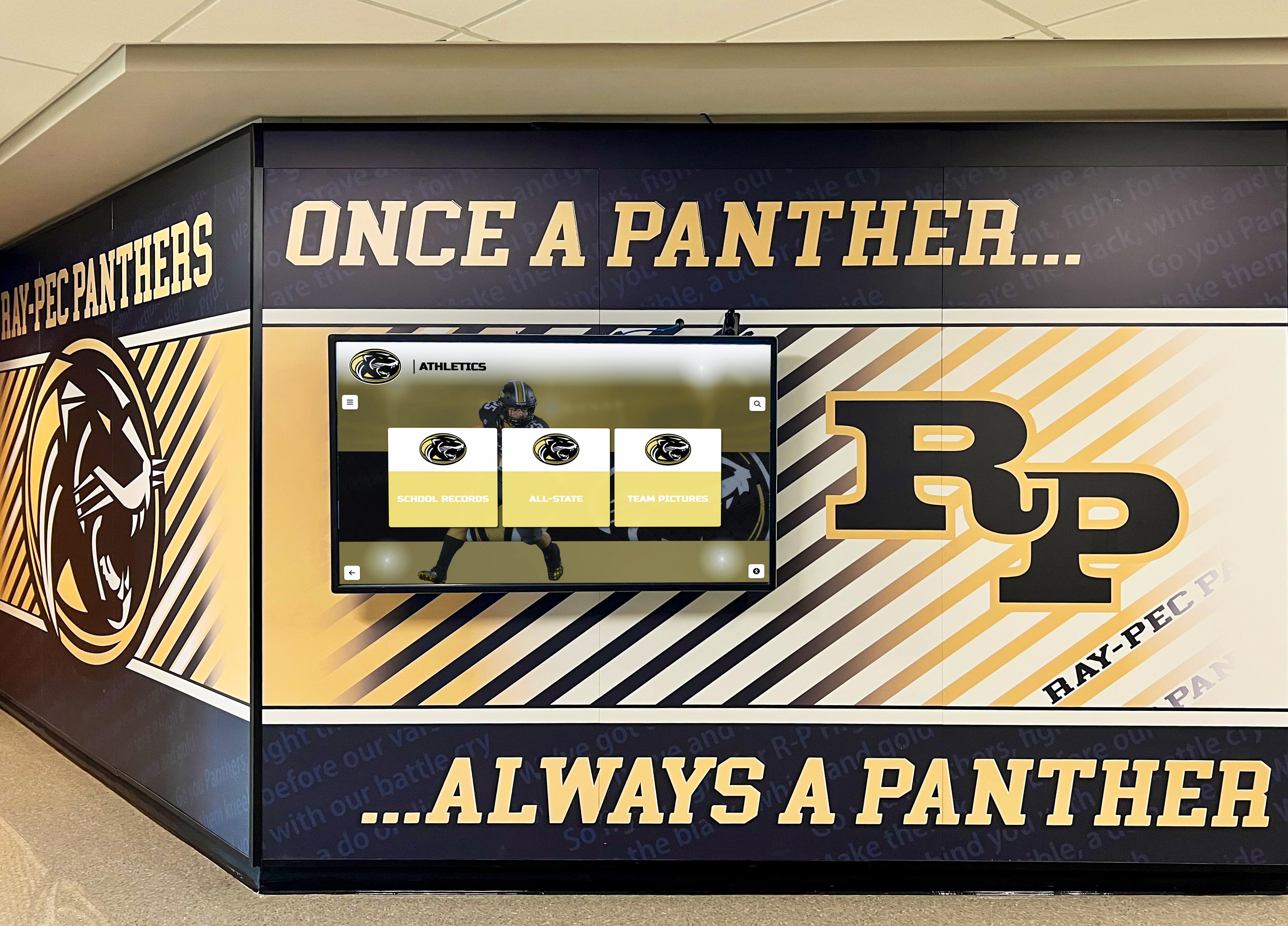
Uptime and Reliability Track Records reveal whether providers deliver consistent operation or frequently fail. Request specific uptime statistics and contact references about their actual reliability experiences. Systems operating at 99%+ uptime appear virtually always available, while 95% uptime—seemingly high—means displays remain non-functional roughly 18 days per year. For recognition displays serving as facility centerpieces, reliability matters enormously.
Remote Monitoring and Support capabilities enable providers to identify and resolve issues proactively before you experience problems. Cloud-connected systems supporting remote diagnostics, software updates, and content management from anywhere reduce on-site maintenance requirements while accelerating issue resolution. Providers lacking remote capabilities require physical access for every update and troubleshooting session—creating ongoing administrative burdens.
Data Security and Privacy Protections become increasingly critical as schools manage student information. How do providers secure biographical data, photos, and achievement records? Where do they store information—on-premise, in cloud services, or hybrid approaches? Do their systems comply with relevant privacy regulations including FERPA requirements for educational records? Reputable providers maintain clear privacy policies, regular security audits, and transparent data handling practices.
Scalability and Future Expansion determine whether systems gracefully accommodate program growth or require expensive upgrades. Can platforms easily add more content, additional displays, or expanded features without starting over? Providers building scalable architectures from the beginning enable organic growth, while systems designed for fixed capacities become limitations requiring replacement as programs expand.
Understanding Pricing Models and Total Cost of Ownership
Sticker prices often obscure true costs—comprehensive evaluation requires understanding complete financial implications over systems’ useful lives.
Common Pricing Structures Explained
Digital hall of fame providers employ various pricing models with dramatically different long-term implications:
One-Time Purchase Models charge substantial upfront fees for hardware, software, installation, and perpetual licenses. These approaches minimize ongoing costs but require large initial investments and may charge separately for updates, support, or feature additions. One-time models suit programs with available capital budgets but limited ongoing operational funding.
Subscription and Annual License Models spread costs over time through recurring fees covering software access, cloud hosting, updates, and support. While reducing initial investment, subscriptions create perpetual obligations that accumulate significantly over years. Evaluate subscription pricing carefully—seemingly modest annual fees compound dramatically over 5-10 year planning horizons. Solutions like Rocket Alumni Solutions provide transparent subscription structures with comprehensive services included rather than hidden add-on charges.
Hybrid Pricing Combining Upfront and Recurring Charges involves initial hardware and installation costs plus ongoing software subscriptions or support fees. These models require evaluating both components comprehensively—low hardware pricing may hide expensive ongoing subscriptions, while substantial initial investments may include long-term support minimizing future costs.
Per-Update or Transaction-Based Pricing charges fees for each content addition, update, or modification. Legacy providers often employ these models, creating vendor dependencies and unpredictable long-term costs. Athletic programs adding dozens of honorees annually face accumulating charges that quickly exceed subscription-based alternatives. Avoid providers whose business models incentivize making updates difficult or expensive.
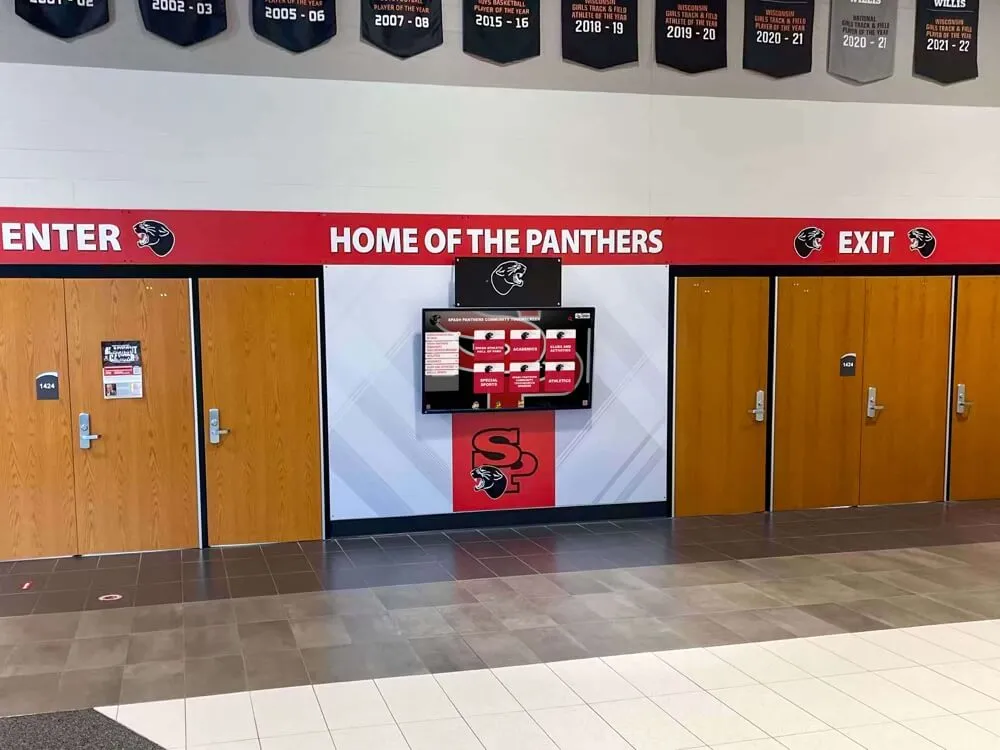
Custom Enterprise Pricing applies to large implementations across multiple facilities or complex integrations with existing systems. Providers may negotiate unique arrangements for districts or large institutions. While offering flexibility, custom pricing requires careful contract review ensuring you understand exactly what’s included, what incurs additional charges, and how costs evolve over time.
When comparing providers, create consistent 5-year total cost calculations including all expenses—hardware, software, installation, training, support, updates, and any recurring fees. This comprehensive view reveals which seemingly expensive solutions actually deliver better value while identifying “affordable” options hiding significant ongoing costs.
Hidden Costs and Budget Considerations
Beyond provider invoices, successful implementations incur additional costs many athletic directors overlook during initial evaluation:
Installation and Facility Preparation expenses vary dramatically based on physical locations and existing infrastructure. Wall-mounted displays require proper mounting surfaces and secure installation. Floor-standing kiosks need adequate clearance and protection from damage. All installations require power access and network connectivity—potentially necessitating electrical work and network cabling. Budget $1,000-$3,000 beyond hardware costs for professional installation and infrastructure preparation unless you have exceptional existing conditions.
Initial Content Development represents substantial time investment converting historical achievements, gathering photos and biographical information, and creating the profile library that makes digital systems valuable. Providers offering content migration services charge $2,000-$10,000+ depending on volume and complexity. Alternatively, dedicating internal staff time requires realistic assessment of the hours involved—potentially dozens or hundreds depending on program history and desired comprehensiveness.
Training and Change Management ensures staff members can confidently manage systems while coaches and administrators understand how to leverage recognition platforms effectively. While provider training may be included, allocate time for internal knowledge transfer, documentation development, and ongoing skill-building as staff turnover occurs. This investment prevents systems from falling into disuse when the one person understanding content management leaves your program.
Ongoing Content Management Time continues indefinitely—adding new achievements, updating profiles as athletes achieve post-graduation success, featuring seasonal content, and maintaining quality standards. Estimate realistic staff time requirements, typically 2-5 hours monthly for active programs. This isn’t a provider cost, but represents real resources your program must commit for success.
Maintenance, Support, and Replacement Planning extends beyond initial warranties. Commercial displays typically last 7-10 years, requiring eventual replacement regardless of software platform longevity. Factor technology refresh costs into long-term budgets, allocating approximately 10-15% of initial investment annually toward eventual replacement reserves. Extended warranties covering hardware failures during years 4-7 typically cost 5-10% of hardware prices annually—reasonable insurance for expensive installations in high-visibility locations.
Opportunity Costs of Wrong Choices exceed financial calculations—systems failing to deliver value waste political capital, frustrate stakeholders, and create change-resistance when proposing future technology initiatives. This intangible cost makes careful provider selection essential even if it requires additional time and evaluation effort.
Vendor Evaluation Process and Due Diligence
Systematic evaluation prevents overlooking critical factors while ensuring you gather consistent information enabling meaningful provider comparisons.
Essential Questions for Provider Demonstrations
Request live demonstrations rather than relying solely on marketing materials, and use these opportunities to ask penetrating questions revealing provider capabilities:
Content Management Questions:
- Can I see the actual content management interface administrators use daily?
- Walk me through adding a new athlete profile from scratch—how many steps does it require?
- How do I bulk import 50 historical records with photos?
- Show me your approval workflow for content requiring review before publication
- What happens if I need to correct an error after publishing?
- Can I schedule content updates in advance for future dates?
- How do you handle content versioning and change tracking?
User Experience Questions:
- Let me use the touchscreen interface myself without guidance—can I find specific content?
- Show me how someone unfamiliar with this system would explore achievements
- What happens when the display isn’t being touched?
- How responsive is touch interaction under typical network conditions?
- Can users access this content online from their phones?
- How do you accommodate users with accessibility needs?
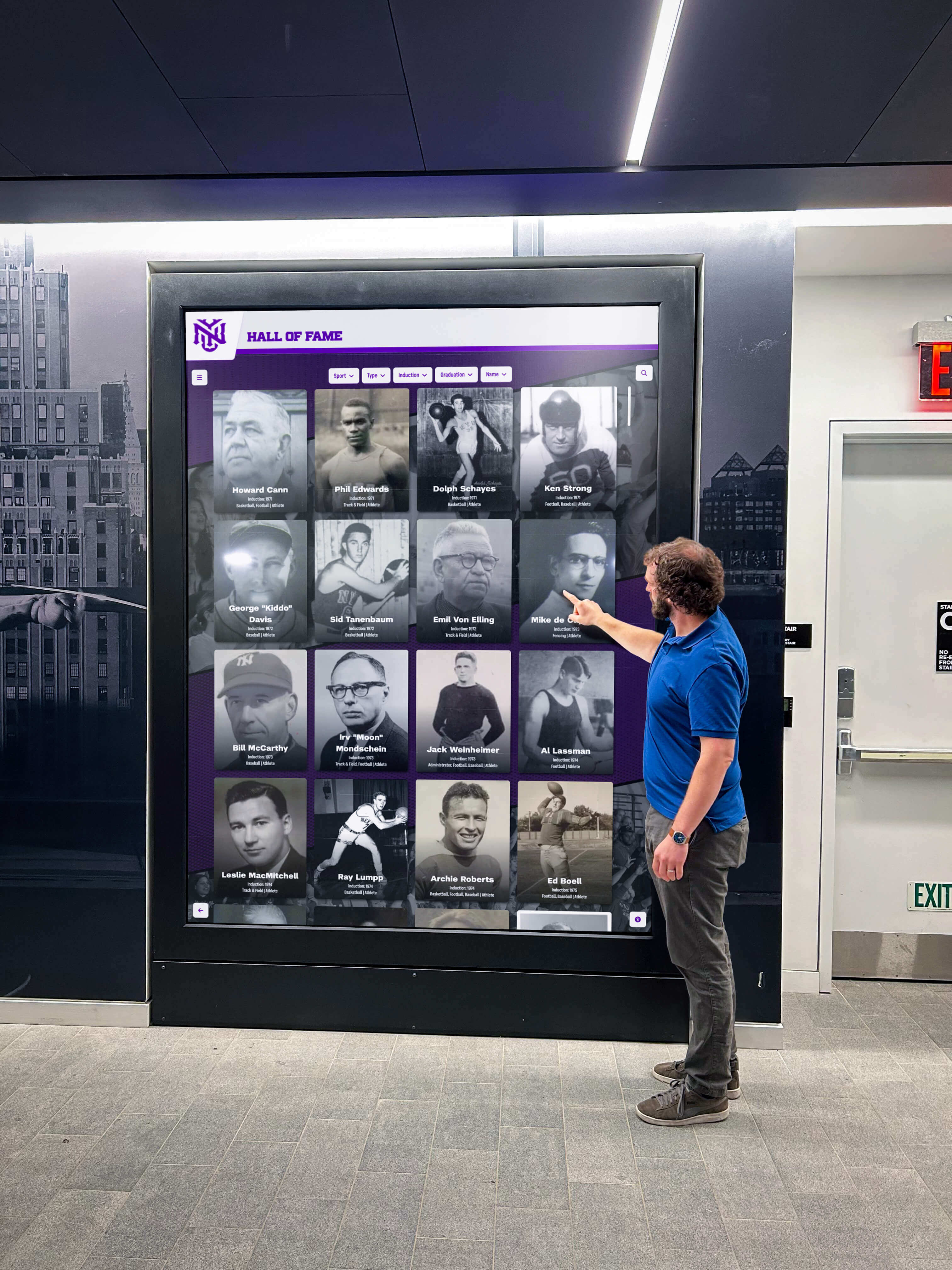
Technical and Support Questions:
- What exactly is included in your base pricing versus optional add-ons?
- Explain your typical implementation timeline from contract to launch
- What training do you provide for our staff?
- How do you handle technical support—what response times can we expect?
- Show me your uptime statistics and reliability data
- What happens if hardware fails—what are replacement timeframes?
- How do software updates work—do they require downtime or service calls?
- What analytics do you provide about system usage and engagement?
Vendor Relationship Questions:
- How many K-12 athletic department installations do you have?
- Can you provide five references we can contact from similar programs?
- What’s your company’s history and financial stability?
- How do you handle feature requests and product development?
- What happens to our content if we ever change providers?
- Explain your data security practices and privacy protections
- Do you have any athletic director users we could speak with?
Providers unable or unwilling to answer these questions substantively raise red flags. Vague responses, evasive answers, or pivots to different topics suggest either inexperience or deliberate obscuring of limitations.
Reference Checks and Site Visits
No evaluation substitute exists for speaking with current customers using providers’ systems in real-world conditions:
Reference Check Questions:
Contact multiple references rather than only the showcase accounts providers eagerly offer. Ask questions revealing actual experiences beyond polished case studies:
- How long have you used this system? Would you purchase it again?
- What aspects work better than expected? What disappointments have you encountered?
- How responsive is support when you encounter issues?
- Has the provider delivered promised features and capabilities?
- What’s your actual total cost including all fees beyond initial purchase?
- How much time does content management require weekly or monthly?
- What advice would you give someone evaluating this provider?
- Are there features you wish you had or capabilities that don’t work as advertised?
- How has the provider handled system updates and improvements?
- Would you recommend this provider to other athletic directors? Why or why not?
Site Visit Observations:
Whenever possible, visit installations observing systems operating in environments similar to yours:
- Watch how actual students and visitors interact with displays—do they engage or ignore them?
- Examine content quality and comprehensiveness—does recognition feel thorough or sparse?
- Assess integration with facility aesthetics—does the system feel like natural fit or afterthought?
- Note physical installation quality—is mounting secure and professional or substandard?
- Ask on-site staff about actual management experience beyond what references may share
- Photograph or video successful design elements you want to replicate
- Identify potential issues or concerns you’ll address in your own implementation
Site visits provide insights impossible to gain through demonstrations and sales presentations, revealing how systems perform after initial enthusiasm fades into daily operational reality.
Contract Review and Negotiation Points
Before signing agreements, carefully review contracts with attention to terms beyond just pricing:
Scope of Services and Deliverables should be explicitly documented—exactly what hardware, software, installation, training, support, and ongoing services does pricing include? Vague language like “turnkey solution” or “complete system” leaves room for disputes about what’s actually provided versus additional-cost options.
Service Level Agreements (SLAs) for support response times, system uptime, and issue resolution determine whether providers deliver promised service quality. Without documented SLAs, you have no recourse when support proves inadequate. Acceptable SLAs include 99%+ uptime commitments, 24-48 hour response times for support requests, and defined escalation processes for urgent issues.
Content Ownership and Portability should clearly establish that you own all content, photos, and data uploaded to systems. Contracts should include explicit data export rights enabling you to retrieve complete information if you ever change providers. Avoid agreements where providers claim ownership or restrict data access.
Warranty Coverage and Hardware Replacement terms determine financial exposure if equipment fails. Understand what warranty periods cover, what they exclude, and what extended warranty options exist. Clarify who handles repairs, where service occurs, and what happens if parts become unavailable.
Contract Duration, Renewal, and Termination terms significantly impact long-term costs and flexibility. Multi-year contracts may offer lower pricing but reduce flexibility if requirements change or providers fail to deliver. Understand exactly what happens at contract end—automatic renewal unless cancelled, renegotiation opportunities, or required migration to new agreements. Ensure reasonable termination provisions exist if providers dramatically fail to meet commitments.
Price Protection and Cost Escalation clauses prevent unexpected dramatic price increases. Contracts spanning multiple years should cap annual increases to reasonable percentages tied to inflation indexes rather than giving providers unlimited pricing discretion.
Liability Limitations and Indemnification protect you from financial exposure if systems fail, cause damage, or create legal issues. Review these provisions carefully, potentially with legal counsel, ensuring adequate protections exist.
Consider requesting modifications to standard provider agreements protecting your interests. Many athletic directors accept template contracts without negotiation, missing opportunities for terms better serving their programs.
Implementation Planning and Long-Term Success Strategies
Selecting the right provider represents only the beginning—thoughtful implementation and ongoing management determine whether systems deliver promised value.
Creating Comprehensive Implementation Timeline
Successful digital hall of fame launches require coordinated planning across multiple workstreams:
Pre-Implementation Phase (Weeks 1-4):
- Finalize provider selection and execute contracts
- Conduct facility assessment confirming installation requirements
- Form implementation team including athletic director, relevant coaches, administrators, IT staff, and provider representatives
- Develop detailed project plan with milestones, responsibilities, and deadlines
- Begin content planning—defining categories, gathering historical materials, and establishing profiles to include at launch
Infrastructure and Installation Phase (Weeks 5-8):
- Complete any necessary facility preparation—electrical work, network installation, mounting surface preparation
- Coordinate equipment delivery and installation scheduling to minimize disruption
- Conduct professional installation with proper mounting, cable management, and aesthetic integration
- Verify network connectivity, system functionality, and performance meeting specifications
- Address any installation issues before proceeding to content development
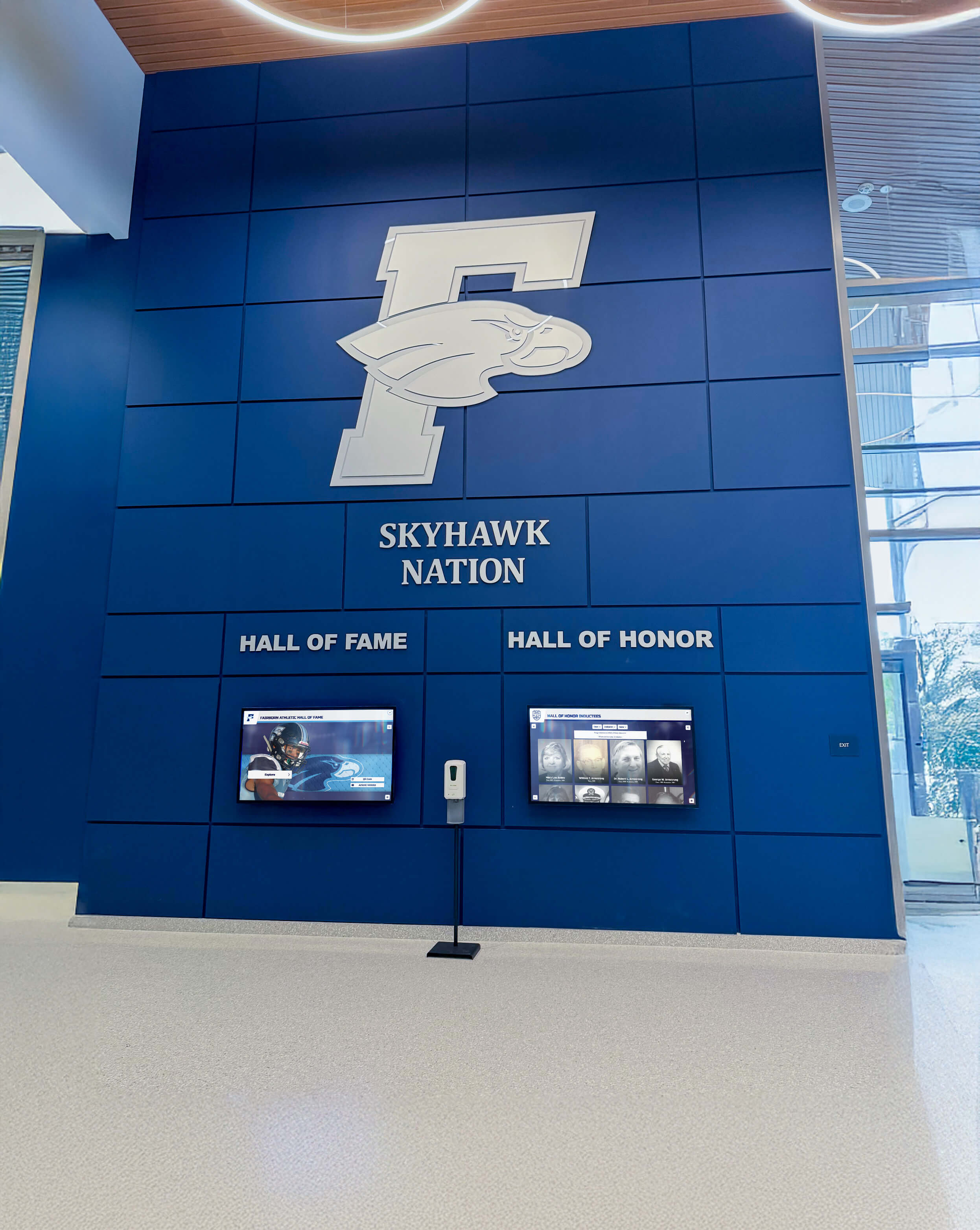
Content Development and Training Phase (Weeks 9-12):
- Conduct comprehensive staff training on content management platform
- Begin creating initial content library—athlete profiles, team pages, championship histories, and record documentation
- Develop style guide establishing standards for photos, text, and biographical information
- Implement content approval workflow ensuring quality before publication
- Test user experience with diverse stakeholders providing feedback on navigation and content discoverability
Launch and Promotion Phase (Weeks 13-16):
- Soft launch enabling final testing with limited audiences before full public unveiling
- Grand opening event celebrating new recognition system and honored achievements
- Publicity campaign through school communications, local media, and social channels
- Gather initial feedback from students, athletes, families, and visitors
- Address any identified issues or improvements needed based on early feedback
Most implementations require 12-16 weeks from provider selection through successful launch. Attempts to compress timelines often compromise content quality, training effectiveness, or stakeholder buy-in—undermining long-term success to save a few weeks initially.
Building Sustainable Content Management Practices
Systems remain valuable only when content stays current and comprehensive—establishing sustainable management practices prevents recognition from becoming outdated:
Designate Clear Responsibilities among staff members for various content management tasks. Who updates records when broken? Who creates profiles for new inductees? Who approves content before publication? Who maintains photo libraries? Without explicit assignments, crucial tasks fall through cracks or overwhelm single individuals.
Create Efficient Workflows streamlining repetitive processes. Develop profile templates with standard sections, maintain ready-to-use photo specifications and style guides, establish approval workflows moving content systematically from draft to publication, and schedule regular content review ensuring accuracy and currency.
Engage Broader Community in content development, distributing workload while deepening engagement. Student journalism or digital media classes can create biographical content as course projects. Alumni can submit personal information and photos updating their profiles. Coaches can identify achievement milestones warranting recognition within their sports. Community involvement strengthens content while building ownership across stakeholder groups.
Schedule Regular Content Reviews ensuring recognition remains current and comprehensive. Quarterly reviews identify needed updates—new records broken, post-graduation athlete achievements, missing historical content, and opportunities for featured content highlighting relevant seasonal themes. Scheduled reviews prevent indefinite procrastination turning into years without updates.
Leverage Analytics Understanding Engagement patterns guiding content development. Review which profiles receive most views, what searches users conduct, how long typical sessions last, and what content types drive extended engagement. This data reveals what resonates with your specific community, informing future content priorities.
Measuring Success and Demonstrating Value
Justify investments and build support for future enhancements by documenting tangible outcomes:
Quantitative Metrics provide objective measures of system utilization and reach:
- Total usage sessions and unique visitors monthly
- Average session duration and pages viewed per visit
- Most-viewed profiles and frequently searched terms
- Online access statistics for web-based content
- Social media shares and extended reach beyond physical location
- Comparison of engagement versus previous traditional displays
Qualitative Outcomes capture cultural and community impacts:
- Stakeholder feedback from athletes, families, coaches, and visitors
- Alumni engagement levels and reconnection stories
- Student and athlete motivation anecdotes
- Recruiting impact on prospective athletes and families
- School pride indicators through surveys or community sentiment
- Media attention and community recognition
Return on Investment Calculations demonstrate financial value through:
- Eliminated costs for traditional plaque fabrication and trophy case maintenance
- Staff time savings managing content versus previous approaches
- Enhanced alumni engagement supporting fundraising and philanthropy
- Improved recruiting outcomes reducing athlete recruitment marketing costs
- Extended recognition useful life compared to physical displays requiring periodic replacement
Regular reporting on these metrics and outcomes maintains leadership support, builds political capital for future initiatives, and validates investment in modern recognition technology. Athletic directors who systematically document value position themselves for continued support when proposing program enhancements.
Common Pitfalls to Avoid When Selecting Providers
Learning from others’ mistakes prevents costly missteps during your provider evaluation:
Prioritizing Price Over Value tempts budget-conscious programs toward the cheapest options, often discovering that limited capabilities, poor reliability, or expensive ongoing costs make “affordable” solutions expensive disappointments. The lowest-priced provider rarely delivers best long-term value. Evaluate total cost of ownership and capability alignment rather than just initial pricing.
Insufficient Stakeholder Involvement during evaluation and planning creates systems that fail to serve key constituencies. When athletic directors select providers without coach input, administrator support, or athlete perspective, implementations often miss requirements that only become apparent after expensive commitments. Broaden evaluation teams despite coordination complexity.
Underestimating Content Development Effort causes implementations to stall when organizations realize creating comprehensive profile libraries requires far more time than anticipated. Many athletic directors launch systems with impressive technology but minimal content—expensive equipment showcasing sparse recognition that fails to justify investment. Realistically assess content development capacity and budget accordingly for internal effort or professional services.
Overlooking Technical Infrastructure Requirements leads to installations that never work properly due to inadequate network connectivity, improper electrical service, or unsuitable physical locations. Verify infrastructure requirements early and budget for necessary improvements rather than discovering shortcomings after equipment delivery.
Ignoring Long-Term Support and Vendor Viability creates risk when providers go out of business, discontinue products, or get acquired by companies changing support models. Evaluate provider financial stability, market position, and likelihood of long-term viability. Impressive startups offering innovative solutions may not survive to support your investment over 5-10 year horizons. For guidance on related recognition solutions, explore resources on athletic record board selection.
Accepting Marketing Claims Without Verification allows providers to oversell capabilities that don’t materialize in real deployments. Request demonstrations of actual systems, speak with current customers, visit installations, and verify claims through independent research rather than accepting marketing materials at face value.
Rushing Decisions Due to Timing Pressures compromises thorough evaluation. External deadlines—end of fiscal years, facility opening dates, anniversary celebrations—create urgency that providers may exploit to prevent proper due diligence. While timing considerations matter, they rarely justify inadequate evaluation that results in wrong selections serving programs poorly for years.
Conclusion: Making Confident Provider Decisions for Your Athletic Program
Selecting the right digital hall of fame provider represents one of the most visible and impactful technology decisions athletic directors make. The system you choose will shape how your program celebrates achievement, inspires current athletes, preserves institutional traditions, and engages alumni for the next decade or more.
The complexity of this decision—evaluating technical capabilities, assessing vendor relationships, understanding financial implications, and forecasting long-term suitability—demands systematic approaches rather than rushed judgments or decisions driven primarily by pricing considerations.
By thoroughly understanding your program’s specific needs, carefully evaluating providers against consistent criteria, conducting comprehensive due diligence through references and site visits, and planning thoughtful implementations, you position your athletic program for recognition success that delivers value far beyond initial investment.
Remember that the best provider for your program may differ from what other athletic directors choose. Your recognition philosophy, budget constraints, technical capabilities, and stakeholder priorities create unique requirements that generic “best” recommendations may not address. Focus on finding the provider whose capabilities, approach, and partnership style align with your specific situation rather than simply selecting whoever others recommend or whoever offers the lowest pricing.
Modern solutions like Rocket Alumni Solutions demonstrate how purpose-built platforms specifically designed for athletic recognition deliver capabilities that generic digital signage or repurposed classroom technology cannot match. When evaluating providers, prioritize those specializing in educational recognition over companies treating athletic halls of fame as minor product variations alongside their primary business focus.
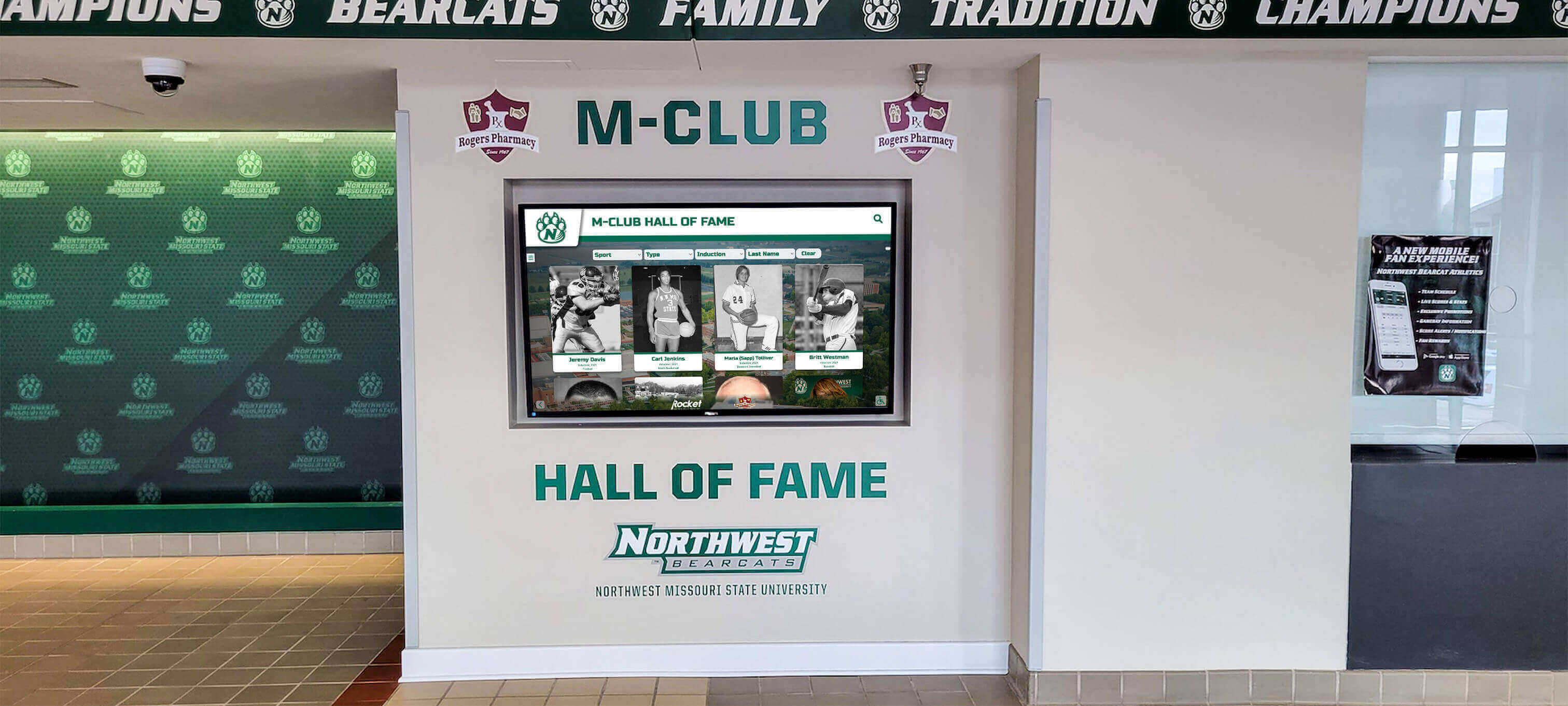
The right digital hall of fame provider will become a long-term partner in preserving your program’s legacy, celebrating athletic excellence, and building the sense of pride and tradition that defines great athletic programs. Take the time to choose wisely—your athletes, coaches, alumni, and institution will benefit from thoughtful selection for years to come.
Ready to explore how modern digital recognition platforms can transform your athletic program? Discover more about selecting the best school hall of fame walls or learn strategies for building school pride through digital displays. For personalized guidance on choosing the right provider for your specific needs, contact Rocket Alumni Solutions to discuss how comprehensive recognition platforms can elevate how you honor athletic achievement and strengthen your program’s culture.
